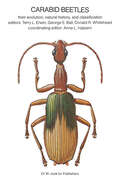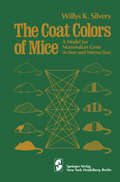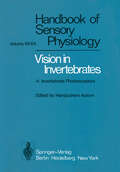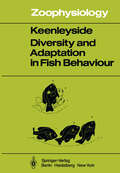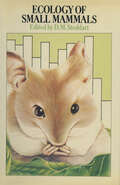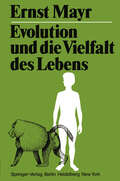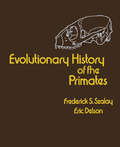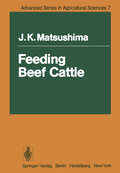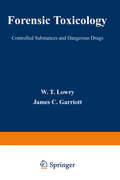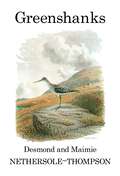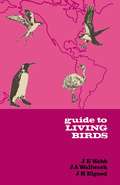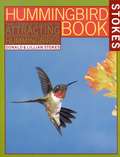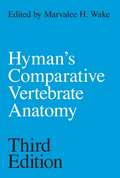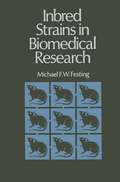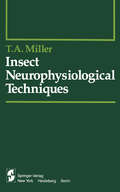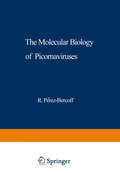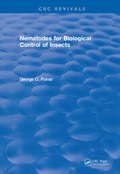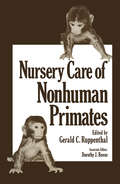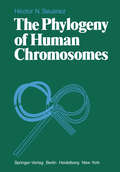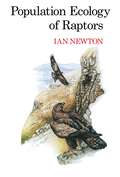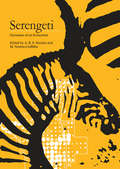- Table View
- List View
Carabid Beetles: Their Evolution, Natural History, and Classification
by T. L. Erwin George E. Ball D. R. Whitehead A. L. HalpernProceedings of the First International Symposium of Carabidology held at the Smithsonian Institution, Washington, D.C., August 21, 23 and 25, 1976
The Coat Colors of Mice: A Model for Mammalian Gene Action and Interaction
by W.K. SilversMany investigators seem to be fascinated by the coat colors of the mam mals with which they work. This seems to be the case particularly for those utilizing isogenic strains of mice, not only because such strains display wide ly different phenotypes, but because scientists, by definition, are an inquisi tive lot and it is sometimes difficult for the uninitiated to comprehend how such phenotypes are produced. This bewilderment becomes even more ap parent if the investigator happens to be involved in breeding studies and a number of attractively colored animals, quite different from the original stocks, appear. Thus I can recall numerous occasions when my colleagues, frequently working in areas completely unrelated to any aspect of genetics, have come to me with an attractively pigmented animal or, more likely, with a popUlation of segregating coat color types (usually because they have not tended their animals properly and have ended up with a cage full of F 2S displaying a number of different colors). How, they ask, do such colors come about? While in some cases it is easy to take chalk in hand and explain what has been going on (segregating) and why, in other cases it is virtually impossible. It is extremely difficult because while the interactions of many coat-color factors obey the simple laws of heredity and of predictable gene interactions, others do not.
Comparative Physiology and Evolution of Vision in Invertebrates: A: Invertebrate Photoreceptors (Handbook of Sensory Physiology #7 / 6 / 6 A)
by H. Autrum M. F. Bennet B. Diehn K. Hamdorf M. Heisenberg M. Järviletho P. Kunze R. Menzel W. H. Miller A. W. Snyder D. G. Stavenga M. YoshidaIn the comparative physiology of photoreception by the Protista and the invertebrates two aspects are emphasized: (1) the diversity of visual processes in these groups and (2) their bearing upon general mechanisms of photoreception. Invertebrates have evolved a far greater variety of adaptations than vertebrates modifications aiding survival in the remarkably different biotopes they occupy. The number of species in itself suggests this multiformity; each of them has peculiarities of its own, in morphology as well as in physiology and behavior. But these special adaptations are variations on a few great themes. Although the catalogue of invertebrate species is immense, the literature concerning them nearly rivals it in extent-even if one considers only that fraction dealing with visual physiology. Taxonomy proceeds by grouping the species, categorizing them in genera, families, orders, and progressively larger units. Similarly, comparative physiology aims at an analogous, more or less compre hensive, classification. This Part A of Volume VII/6, like Part B that follows it, emphasizes the broad questions that concern groups larger than the individual species; in some cases these questions have general applicability. The middle course between approaches that are too specialized and those that are too general is often elusive, but here we attempt to follow it. The vast number of special adaptations-probably, as we have said, as large as the number of species-is beyond the range even of a handbook.
Diversity and Adaptation in Fish Behaviour (Zoophysiology #11)
by Miles H.A. KeenleysideFish are extremely successful vertebrates. Because of a long and divergent history they are now found in almost every conceiv able aquatic habitat. This radiation has been accompanied by great diversity in structure, physiology, and behaviour. Despite this variability, fish must solve a number of basic problems that are common to all animals. The most important of these are: (1) to find and ingest appropriate food; (2) to avoid predation; and (3) to reproduce. The main purpose of this book is to describe the variety of behavioural strategies that fish use in coping with these problems. My approach has been to draw together material from both field and laboratory work that is widely scattered in the litera ture. The major emphasis is on field studies, since my main concern is with adaptive solutions to problems, and I believe these are most likely to be correctly perceived by workers who are familiar with the natural ecological setting of their animals. Of course, many details of behaviour cannot be seen and quantified adequately in the field, and therefore I have not ignored laboratory studies. However, even here I have concen trated on work that illustrates the variety of solutions that fish use to solve the three basic problems. Much important work, for instance on causation, development, and learning, is not included.
Ecology of small mammals
by D. M. StoddartFrom their largely descriptive beginnings about a half century ago, studies on the ecology of small mammals have mushroomed in number, scope, content and complexity. Yet strangely, or perhaps not so strangely if one considers the extent and complexity of ecological interactions, the main problems for which the early workers sought answers still defy complete analysis, and basic hypotheses remain untested if not even untestable. The same holds true for so many branches of animal ecology that it seems to be the complexity of the concepts that frustrates efforts rather than the subject species. Like all branches of science, small mammal ecology has been subject to a series of fashionable approaches, one following another as tech nology penetrates previously impregnable regions. Doubtless the future development of our science will be punctuated by wave upon wave of new endeavour in whole fields that are perhaps even yet unidentified. Answers to the complex questions which ecologists ask do not come easily. Increasingly though, they arise in direct proportion to the efforts expended upon their elucidation. Many studies have achieved such a high level of elegance, in terms of manpower and apparatus, that there is a feeling that questions asked when such resources are unavailable are not worth asking. Nothing could be further from the truth. Many a complex model has failed fully to explain the phenomenon for which it was construc ted because of a lack of basic field data on the species' natural h~story.
Evolutionary History of the Primates
by Frederick S. Szalay Eric DelsonEvolutionary History of the Primates presents a documentation and analysis of the fossil record and evolutionary history of the primates to facilitate the understanding of the genealogy, adaptations, dispersal, and taxonomy of the order. The book consists of 13 chapters; each chapter is devoted to a specific genera or higher taxa of primates. The chapters contain available information on the morphology, relationships, and adaptations of primate groups. The book clarifies discussed points or documents interpretations, and it indicates the type of fossil material available for each taxon. The text will be valuable to many researchers and students who need a source of data and interpretations about fossil primates.
Feeding Beef Cattle (Advanced Series in Agricultural Sciences #7)
by J.K. MatsushimaThe purpose of this book is to provide the reader with some basic information applicable to cattle feeding. It is intended to adapt some of the basic principles of nutrition in applied form. During the past few decades there have been various changes in type and form of feeds available for livestock feeding due to new kinds of equipment. Mechanization has made it possible to perform certain opera tions of the beef production program more efficiently and economically. With all the new innovations and advances in animal nutrition combined with the capabilities of the computer, it becomes very challenging for everyone to keep up to date on the latest information in the field of cattle feeding and production. The text was written with the intent of utilizing the raw materials, facilities, equipment, etc. which are available in the United States. The terminology of certain materials such as feed ingredients will vary from one country to another. One term which is frequently used in this text is forage. Although the term roughage is used more commonly in the United States it has been replaced with forage in this text. J.K. MATSUSHIMA Fort Collins, January 1979 Contents Chapter 1 Nutrients 1 Proximate Feed Analysis 1 Chemical Classification of Nutrients 2 1.1 Water 3 1.1.1 Drinking Water .... ....
Forensic Toxicology: Controlled Substances and Dangerous Drugs
by W. LowryWith the rapid spread of drug use and abuse in this country over the last decade, events relating to drugs have become increasingly prominent in the court of law as well as in society in general. It is anticipated that throughout the 1980s this problem will continue to be one of the major social problems in the United States. With the complexity of the Federal and state laws and their interrelationships, and with the increasing demand for the expert chemist or toxicologist, or both, in the courtroom, more education for these people relating to drugs must be implemented. The prosecuting and defense attorneys are also in need of accurate toxicological information to adequately handle cases in which drugs playa role. This book is intended to be a practical as well as an educational book-a resource tool for the active forensic chemist, as well as for the student. It is with the forensic chemist in mind that the material on controlled substances and substances found in cases of drug abuse has been arranged in a systematic order for quick and easy reference. This section includes synonyms, pharma ceutical preparations, biochemistry and/or pharmacognosy, toxicology and/or pharmacology, and how the substance is controlled under Federal law. Under the concept of scientific consideration as compared with the Federal law, this book enables one to deal with some of the major conflicts in the American legal system concerning scientific evidence and how it is presented in a court of law.
Greenshanks (Poyser Monographs)
by Desmond Nethersole-Thompson Maimie Nethersole-ThompsonDesmond Nethersole-Thompson has been studying his favourite bird, the greenshank Tringa nebularia, since May 1932. This book, published in 1976, owes much to the interest, almost an obsession, of the Nethersole-Thompson family. The two girls and four boys, as well as both parents, now work as a team in the wild and beautiful north-west Highlands of Scotland. Greenshanks has drawn heavily on the team's field notebooks. In the gneiss country of Sutherland, so different from the forest bogs of Spey Valley, Fennoscandia and the Soviet Union, they have particularly concentrated on the greenshank's displays and breeding, food and feeding behaviour and its remarkable voice. There can be few long-term projects on waders to equal this made by the Nethersole-Thompsons, and there are valuable specialist contributions by other eminent ornithologists. Greenshanks is a major contribution to bird studies and takes its place beside Desmond Nethersole-Thompson's four earlier monographs. The illustrations in colour and monochrome by Donald Watson have all the veracity and atmosphere that one has come to expect of this gifted artist.
The Hummingbird Book: The Complete Guide to Attracting, Identifying,and Enjoying Hummingbirds
by Donald Stokes Lillian StokesAttract amazing hummingbirds to your backyard! With this comprehensive, beautifully illustrated guide, you'll find it easy to attract these tiny jewel-like birds to your own yard. With this comprehensive, beautifully illustrated guide, you'll find it easy to attract these tiny, jewel-like birds to your own yard. The Stokes Hummingbird Book provides all the information you need to bring hummingbirds up close, identify them, and understand their fascinating and varied behavior. The book includes:Range maps and full-color photographs to help you identify and locate hummingbirdsInformation on how to select the proper feeders, what to use in them, when to put them up, and when to take them downAdvice on what flowers to plant to attract hummingbirds in your part of the countryAmazing facts about hummingbirds, such as how fast they fly and how much they weighGuidelines for photographing hummingbirdsComplete information on hummingbird behavior, including flight displays, breeding habits, and feedingA special section on attracting orioles, with photographs and behavior guides for each of the eight species found in North AmericaA resource list for hummingbird supplies
Hyman's Comparative Vertebrate Anatomy
by Marvalee H. WakeThe purpose of this book, now in its third edition, is to introduce the morphology of vertebrates in a context that emphasizes a comparison of structire and of the function of structural units. The comparative method involves the analysis of the history of structure in both developmental and evolutionary frameworks. The nature of adaptation is the key to this analysis. Adaptation of a species to its environment, as revealed by its structure, function, and reproductive success, is the product of mutation and natural selection–the process of evolution. The evolution of structure and function, then, is the theme of this book which presents, system by system, the evolution of structure and function of vertebrates. Each chapter presents the major evolutionary trends of an organ system, with instructions for laboratory exploration of these trends included so the student can integrate concept with example.
Insect Neurophysiological Techniques (Springer Series in Experimental Entomology)
by T.A. MillerInsects as a group occupy a middle ground in the biosphere between bacteria and viruses at one extreme, amphibians and mammals at the other. The size and general nature of insects present special problems to the student of entomology. For example, many commercially available instruments are geared to measure in grams, while the forces commonly encountered in studying insects are in the milligram range. Therefore, techniques developed in the study of insects or in those fields concerned with the control of insect pests are often unique. Methods for measuring things are common to all sciences. Advances sometimes depend more on how something was done than on what was measured; indeed a given field often progresses from one technique to another as new methods are discovered, developed, and modified. Just as often, some of these techniques find their way into the classroom when the problems involved have been sufficiently ironed out to permit students to master the manipulations in a few laboratory periods. Many specialized techniques are confined to one specific research labo ratory. Although methods may be considered commonplace where they are used, in another context even the simplest procedures may save con siderable time. It is the purpose of this series (1) to report new develop ments in methodology, (2) to reveal sources of groups who have dealt with and solved particular entomological problems, and (3) to describe ex periments which might be applicable for use in biology laboratory courses.
The Molecular Biology of Picornaviruses (Nato Science Series A: #23)
by R. Perez-Bercoffvi The intent, therefore, was to provide for a fresh and original review of all relevant topics and issues in the field, following a comprehensive and coherent programme. Such an ambitious goal could only be reached thanks to the unlimited collaboration of the lecturers: They were requested to produce nothing less than "freer, broader, speculative and personal "considerations of the subjects" they had to cover ••• And so they did: their presentations unfolded a fantastic picture, a most fascinating and meaningful identification of the field, its present problems and trends. But participants at this conference contributed many valuable observations while discussing specific points. Unfortunately, more often than not, it proved impossible to identify them in the records. Accordingly, we incorporated here and there some of these "anonymous" contributions as part of the edited version of the texts. To all of the participants, I would like to express my gratitude for their actively taking part in all the scientific (and social ••• ) activities (lectures, round tables, posters, encounters) of this N.A.T.O. ASl. The result was a stimulating atmosphere, conducive to authentic scientific exchanges. Hence, the success of this meeting should be credited only to them. Finally, on behalf of all participants, I would like to thank Professor Sissini, the Mayor of Maratea, and Mr. B. Vitolo, the Chairman of its Tourist Office: their enthusiastic support greatly contributed to make of our time in their wonderful seaside resort an unforgettable one.
Nematodes for Biological Control of Insects
by George O. PoinarThis book discusses nematodes for biological of insects. The book includes the following chapters; classification of nematode, key to entomogenous nematodes, nematode groups, microorganisms associated with entomogenous nematodes, immunity to entomogenous nematodes, natural enemies of entomogenous nematodes, environmental impact of entomogenous nematodes, and future prospects.
Nematodes for Biological Control of Insects
by George O. PoinarThis book discusses nematodes for biological of insects. The book includes the following chapters; classification of nematode, key to entomogenous nematodes, nematode groups, microorganisms associated with entomogenous nematodes, immunity to entomogenous nematodes, natural enemies of entomogenous nematodes, environmental impact of entomogenous nematodes, and future prospects.
Nursery Care of Nonhuman Primates (Advances in Primatology)
by G. C. RuppenthalThe Infant Primate Research Laboratory at the University of Washington was conceived in 1970 as a small research Wlit primarily for support of two individual's interests in early develop ment of nonhuman primates. Because of their research emphasis, a modest nursery was required to support a small population of animals for specific experimental studies. The laboratory experi enced rapid growth when others at the University became interested in the use of monkeys as models for early development and mental retardation in humans. In 1972 the Wlit was formally established as a core facility of the Child Development and Mental Retardation Center and the Regional Primate Research Center. This joint administrative and financial support allowed us to invest considerable effort in the development of normative data for rearing animals in our nursery as well as for identifying, documenting, and rearing subjects at high risk for neonatal death. As part of that effort, every attempt has been made to promote a multidisciplinary approach to ques tions associated with rearing nonhuman primates. This volume includes much of the information thus gathered. I feel that such an approach is essential to the promotion of scientific principles in rearing and has allowed the laboratory to contribute to prima tology.
The Phylogeny of Human Chromosomes
by H.N. SeuanezThe question of how man has emerged must be as old as human thought itself. However, it was not until last century that, amidst a storm of opposition and highly emotional criticism, man was first conceived as a product of evolution rather than creation. Moreover, it is not yet thirty years since the chemical composition and molecular structure of the hereditary material was fully understood or the chromosome number of man became known. It should not be surprising then, to find how little, at present, we understand how our genes and chromosomes operate, and how they have evolved during phylogeny. In this work I have discussed how our own chromosomes have been transmitted and altered as far back as we may trace their phylogeny into the past. To make the work more complete, the composition and evolution of our own genome had also to be consiered in order to understand some of the recent findings at the chromosome level. These have resulted from using methods for localizing repetitive and single copy DNA sequences in chromosomes. Moreover, the development of biochemical methods of studying evolution at the macromolecular level has not only led to a more complete understanding of the evolutionary mechanisms, but has enabled us to make comparisons with evolutionary change at the chromosome level. In addition, a simple reference to the fossil record was necessary, because impressive discoveries in recent years have supplied valuable data on man's evolution.
The Picnic and Suchlike Pandemonium
by Gerald DurrellIf you loved My Family and Other Animals and can’t get enough of the Durrells after the Corfu series, this is the book for you. It constitutes a series of anecdotal snippets and short stories including ‘The Picnic’, a laugh-out-loud account of an ill-fated Durrell family excursion, which should have been a relaxing, jolly affair. But with the Durrells things are seldom straightforward and on this occasion all that could go wrong did go wrong - except Gerald Durrell's sense of humour in recounting the tale. Other hilarious and surreal Roald Dahlesque stories ensue, including the critically acclaimed Gothic horror story ‘The Entrance’.
Population Ecology of Raptors (Poyser Monographs #113)
by Ian NewtonDr Newton's book is concerned with all aspects of population regulation in diurnal birds of prey, their social behaviour, dispersion, numbers, movements, breeding and mortality. He has drawn on his own studies in Scotland and on material and investigations worldwide to produce an authoritative and stimulating synthesis of current thinking and research on the ecological problems of the Falconiformes. He also deals in detail with the effects of pesticides and other pollutants on these birds, and with their scientific management and conservation. The author's lucid style will ensure a wide readership among research workers and the more general audience with an interest in birds of prey. There is a full bibliography and an extensive appendix of tables.
Research and Practice in Social Skills Training
by A.S. Bellack M. HersenIt is perhaps trite to refer to human beings as social animals, but never theless it is true. A substantial portion of our lives is spent in interactions with other people. Moreover, the nature, quality, and quantity of those interactions have a tremendous impact on behavior, mood, and the adequacy of adjustment. Faulty interpersonal relationship patterns have reliably been associated with a wide variety of behavioral-psychological dysfunctions ranging from simple loneliness to schizophrenia. Most "traditional" analyses of interpersonal failures have viewed them as consequences or by-products of other difficulties, such as anx iety, depression, intrapsychic conflict, or thought disorder. Con sequently, remediational efforts have rarely been directed to interper sonal behavior per se. Rather, it has been expected that interpersonal relationships would improve when the source disorder was eliminated. While this model does account for some interpersonal dysfunctions (e.g., social anxiety can inhibit interpersonal behavior), it is not adequate to account for the vast majority of interpersonal difficulties. In fact, in many cases those difficulties either are independent of or underlie other dysfunctions (e.g., repeated social failure may produce depression or social anxiety).
Serengeti: Dynamics of an Ecosystem
by M. Norton-Griffiths A. R. E. SinclairOriginally published in 1979, Serengeti: Dynamics of an Ecosystem was immediately recognized as the first synthesis of the patterns and processes of a major ecosystem. A prototype for initial studies, Serengeti contains baseline data for further and comparative studies of ecosystems. The new Serengeti II builds on the information presented originally in Serengeti; both books together offer essential information and insights for ecology and conservation biology.
